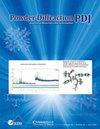卤代芳烃C14H14Cl3O6P的晶体结构
IF 0.4
4区 材料科学
Q4 MATERIALS SCIENCE, CHARACTERIZATION & TESTING
引用次数: 0
摘要
利用同步加速器X射线粉末衍射数据对卤代芳烃的晶体结构进行了求解和细化,并利用密度泛函理论技术对其进行了优化。Haloxon在空间群P21/n(#14)中结晶,a=19.60382(6),b=10.05473(3),c=8.73591(2)Å,β=92.6617(2)°,V=1720.088(11)Å3,Z=4。该结构由离散的分子组成。稠环系统的平均平面约为0–11和011。这些环形成垂直于这些平面的交错堆叠。结构中没有传统的氢键,但几个C–H…O和C–H·Cl氢键对晶体能量有贡献。粉末图案已提交给ICDD,以纳入粉末衍射文件™ (PDF®)。本文章由计算机程序翻译,如有差异,请以英文原文为准。
Crystal structure of haloxon, C14H14Cl3O6P
The crystal structure of haloxon has been solved and refined using synchrotron X-ray powder diffraction data, and optimized using density functional theory techniques. Haloxon crystallizes in space group P21/n (#14) with a = 19.60382(6), b = 10.05473(3), c = 8.73591(2) Å, β = 92.6617(2)°, V = 1720.088(11) Å3, and Z = 4. The structure consists of discrete molecules. The mean planes of the fused ring systems are approximately 0–11 and 011. The rings form staggered stacks perpendicular to these planes. There are no traditional hydrogen bonds in the structure, but several C–H⋯O and C–H⋯Cl hydrogen bonds contribute to the crystal energy. The powder pattern has been submitted to ICDD for inclusion in the Powder Diffraction File™ (PDF®).
求助全文
通过发布文献求助,成功后即可免费获取论文全文。
去求助
来源期刊

Powder Diffraction
工程技术-材料科学:表征与测试
CiteScore
0.90
自引率
0.00%
发文量
50
审稿时长
>12 weeks
期刊介绍:
Powder Diffraction is a quarterly journal publishing articles, both experimental and theoretical, on the use of powder diffraction and related techniques for the characterization of crystalline materials. It is published by Cambridge University Press (CUP) for the International Centre for Diffraction Data (ICDD).
 求助内容:
求助内容: 应助结果提醒方式:
应助结果提醒方式:


